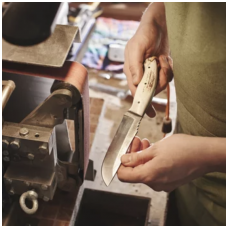Knifemaking: Creating high quality knives

Behind every well-made knife lies a fascinating world of craftsmanship, skill and artistry. Knife making is an ancient craft that has evolved over centuries, combining traditional techniques with modern innovations. In this article, we will explore the complex process of creating high-quality knives, including the various techniques, materials and artistic elements that contribute to their exceptional value.
Selection of materials for the production of knives
The foundation of a great knife starts with choosing the right materials. Knife manufacturers carefully consider the properties of different metals to achieve optimal performance and durability. High carbon stainless steel, e.g. VG10 or S30V, is widely used for its excellent edge retention and corrosion resistance. Damascus steel, a visually stunning material created by layering and forging different steels, is highly sought after for its unique patterns.
Forging and shaping of knife blades
Blade forging is a crucial step in knife making where the selected steel is heated, hammered and shaped to create the blade. Traditional forging methods involve heating steel in a forge and carefully shaping it with hammers and anvils. This process allows the knife maker to give the blade strength, balance and optimal geometry. Some modern knife makers also use stock removal techniques where the shape of the blade is cut from a solid piece of steel using precision equipment.
Metal hardening of knives
After the knife shape is formed, a critical heat treatment process is performed. This involves heating the blade to a certain temperature and cooling it quickly to increase its hardness, strength and flexibility. Proper heat treatment ensures that the blade can maintain a sharp edge and withstand repeated use without becoming brittle or losing its shape.
Knife handle construction
The handle of a knife plays a very important role in its functionality and aesthetics. Handles can be made from a variety of materials, including wood, bone, synthetic composites, e.g. G-10 or Micarta, and even rare materials such as deer antler or mother-of-pearl. The material selected is molded and conforms to the groove of the blade for a secure and comfortable grip. Some knife makers use intricate techniques such as inlay, carving or texturing to give it an artistic look.
Knife assembly and finishing
During assembly, the blade and handle are joined together with pins, screws or glue. The knife maker carefully aligns and secures these components to create a seamless and strong joint. After assembly, the knife is carefully processed. This includes grinding and polishing the blade to achieve a mirror finish, refining the handle for a smooth and comfortable grip, and the overall balance and functionality of the knife.
Artistic knife making techniques
Making knives is not only about functionality, but also about artistic expression. Many knife makers use unique techniques to elevate their creations to the level of true works of art. This can include engraving complex designs on the blade or handle, creating sculptural elements, embellishment with precious metals or gems and decorative techniques such as application of symbols or Damascus patterns. These artistic touches add value, uniqueness and aesthetic beauty to the knives, turning them into collectibles.
In conclusion, the craft of knife making is a labor of love that requires exceptional skill, precision and an eye for detail. From the careful selection of materials to the forging, shaping and finishing processes, every step is a testament to the knife craftsman's dedication. Combining functional design with artistic expression, these skilled craftsmen create high-quality knives that are not just tools, but objects of admiration.




